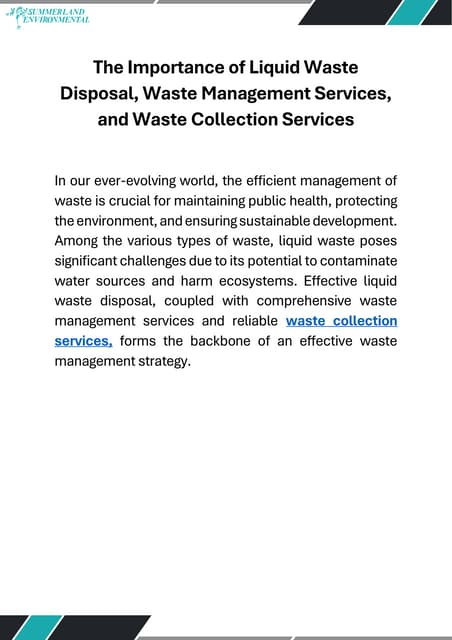Reclaim Waste Things To Know Before You Get This
Reclaim Waste Things To Know Before You Get This
Blog Article
The Ultimate Guide To Reclaim Waste
Table of ContentsThe Of Reclaim WasteThe 3-Minute Rule for Reclaim WasteThe Reclaim Waste IdeasThe Best Strategy To Use For Reclaim WasteLittle Known Facts About Reclaim Waste.
Discover the kinds, occurrences, and kinds of liquid waste. Domestic sewer waste refers to the waste and items from a household septic tank. This sort of waste is produced by humans in residences, institutions, and other structures. This only includes septic systems that have a drain area. The proper monitoring and disposal of domestic sewer waste require fluid waste to be transferred to a sewer treatment plant where the appropriate methods and equipment are related to cleanse and take care of waste.
Commercial waste usually includes prospective hazards, such as combustible products or a mix of fluid and strong waste products, and requires an advanced and in-depth disposal procedure. The disposal of commercial waste typically includes the filtering of waste prior to transport to ensure risk-free and appropriate disposal. Hazardous waste is developed from byproducts and runoff of industrial processes and production.
This type of waste can not utilize the very same sewer monitoring transportation or processes as septic or commercial liquids. The industrial waste management process needs the assessment and screening of fluid waste prior to it goes through the disposal procedure (industrial wastewater treatment). Drainage waste is the fluid waste that originates from drainage and excess stormwater in very booming locations or cities
Runoff waste can trigger contamination and flooding if not handled correctly. Making certain correct waste management can protect against catastrophes and minimize ecological injury.
Little Known Facts About Reclaim Waste.
Contact PROS Providers today to learn about our waste monitoring and disposal services and the correct ways to care for the liquid waste you produce.
(https://penzu.com/p/1f225eb6893bd9aa)Do you understand what takes place to your water when you end, flush the toilet or drain the cleaning machine? No? Well, it deserves understanding. This so-called 'wastewater' is not just a crucial source but, after therapy, will be released to our land, rivers or the sea. Made use of water from toilets, showers, baths, kitchen sinks, washings and industrial procedures is called wastewater.

water made use of to cool down equipment or tidy plant and devices). Stormwater, a type of wastewater, is overflow that flows from farming and city areas such as roof coverings, parks, yards, roads, paths and gutters right into stormwater drains, after rainfall. Stormwater streams untreated directly to local creeks or rivers, eventually reaching the sea.
Top Guidelines Of Reclaim Waste
In Queensland, the majority of wastewater is dealt with at sewage treatment plants. Wastewater is delivered from domestic or industrial websites with a system of sewers and pump stations, referred to as sewerage reticulation, to a sewer treatment plant. Neighborhood federal governments construct, keep and run most sewer treatment plants. Operators are accredited under the Environmental Management Act 1994 to release cured wastewater at an appropriate ecological criterion right into rivers.
The Division of Natural Resources encourages regional governments about handling, operating and preserving sewerage systems and treatment plants. In unsewered locations, city governments may call for owners to set up individual or household sewage therapy systems to deal with domestic wastewater from toilets, cooking areas, bathrooms and washings. The Department of Natural Resources authorises the usage of family systems when they are verified to be effective.
Most stormwater obtains no treatment. In some new communities, treatment of some stormwater to remove clutter, sand and gravel has actually begun using gross toxin traps. Wastewater therapy happens discover here in four stages: Removes solid issue. Larger solids, such as plastics and various other objects mistakenly discharged to sewage systems, are eliminated when wastewater is gone through screens.
Utilizes little living organisms understands as micro-organisms to damage down and get rid of remaining liquified wastes and fine particles. Micro-organisms and wastes are integrated in the sludge.
5 Simple Techniques For Reclaim Waste
Nutrient removal is not offered whatsoever sewage treatment plants because it needs expensive specialised equipment. It is becoming more common in Queensland. Clear fluid effluent generated after therapy might still consist of disease-causing micro-organisms. If this effluent is released into waterways such as rivers or the sea, the micro-organisms will at some point pass away out.

The majority of wastewater streams right into the sewerage system. Under the Act, neighborhood federal governments administer authorizations and licences for ecologically relevant activities (Periods) including wastewater launches that could have a neighborhood influence.
Some Known Facts About Reclaim Waste.
Otherwise, examples are considered laboratory analysis. Usually many tests are required to establish the degrees of each of the various pollutants such as oils, heavy metals and pesticides in water. Tracking gives valid information about water high quality and can verify that permit problems are being fulfilled. The details obtained through tracking provides the basis for making water top quality decisions.
Report this page